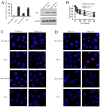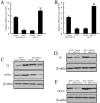53BP1 sensitizes breast cancer cells to 5-fluorouracil
- PMID: 24040364
- PMCID: PMC3765449
- DOI: 10.1371/journal.pone.0074928
53BP1 sensitizes breast cancer cells to 5-fluorouracil
Abstract
Chemoresistance of breast cancer is a worldwide problem for breast cancer and the resistance to chemotherapeutic agents frequently led to the subsequent recurrence and metastasis. In our previous study, we have found that 53BP1 showed a gradual decrease during the progression of breast cancer and loss of 53BP1 was associated with metastasis and poor prognosis in breast cancer. Here we aimed to reveal whether 53BP1 could sensitize breast cancer to 5-Fu. We found that ectopic expression of 53BP1 can significantly sensitize breast cancer cells to 5-Fu while knockdown of 53BP1 conferred the resistance. The in vivo experiments confirmed that overexpression of 53BP1 in combination with 5-Fu markedly inhibited growth of xenotransplanted tumors in nude mice when compared to either agent alone. Furthermore, we demonstrated that 53BP1 regulated the sensitivity to 5-Fu through thymidylate synthase (TS) and dihydropyrimidine dehydrogenase (DPYD). The present studies provide a new clue that combination of 5-Fu and 53BP1 could be a potential novel targeted strategy for overcoming breast cancer chemoresistance.
Conflict of interest statement
Figures








References
-
- Benson JR, Jatoi I (2012) The global breast cancer burden. Future Oncol 8: 697–702. - PubMed
-
- Siegel R, Naishadham D, Jemal A (2012) Cancer statistics, 2012. CA Cancer J Clin 62: 10–29. - PubMed
-
- Longley DB, Harkin DP, Johnston PG (2003) 5-fluorouracil: mechanisms of action and clinical strategies. Nat Rev Cancer 3: 330–338. - PubMed
-
- Edler D, Glimelius B, Hallstrom M, Jakobsen A, Johnston PG, et al. (2002) Thymidylate synthase expression in colorectal cancer: a prognostic and predictive marker of benefit from adjuvant fluorouracil-based chemotherapy. J Clin Oncol 20: 1721–1728. - PubMed
-
- Li LH, Dong H, Zhao F, Tang J, Chen X, et al. (2013) The upregulation of dihydropyrimidine dehydrogenase in liver is involved in acquired resistance to 5-fluorouracil. Eur J Cancer. - PubMed
Publication types
MeSH terms
Substances
LinkOut - more resources
Full Text Sources
Other Literature Sources
Medical
Miscellaneous

